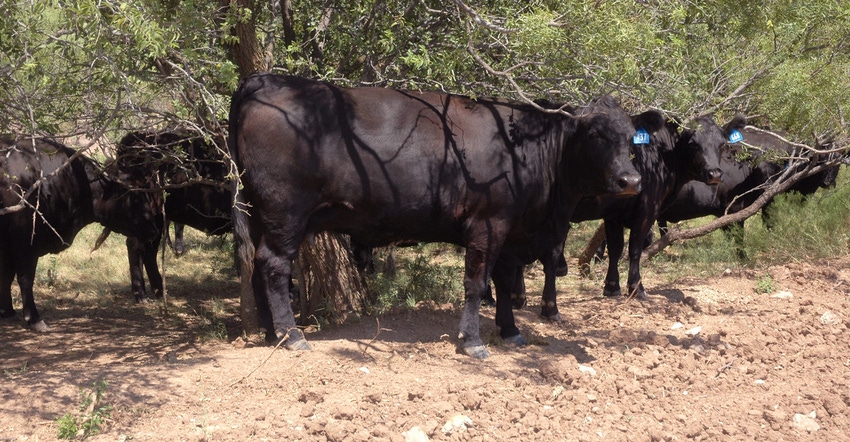Managing heat stress with genetics
Cow hair shedding has a significant economic impact.
March 1, 2020

Sponsored Content
“A lot of times we talk about hair shedding being an indicator trait for heat tolerance,” says Jared Decker, Extension beef genetics and computational genomics specialist at the University of Missouri (MU). “I think of it more as an economically relevant trait because if a cow is not taking off her winter coat, she’s simply not prepared to deal with the heat and humidity.”
Overall, Decker says environmental stress costs the U.S. beef industry more than $1 billion each year. Stressors include cold and high elevations, but he says a major portion of the losses stem from stress associated with heat and/or fescue toxicity.
Besides the economic factor, Decker told participants at this year’s Cattlemen’s College environmental stress on cattle threatens sustainability in other ways, too.
“We have to make sure we are producing cattle in a way that has environmental stewardship, cattle with efficiency, and we need to make sure that we’re responding to social responsibility, raising beef in a way that consumers are comfortable. Finally, we must have profitability,” Decker explains.
“Environmental stress touches on all of those points. If animals are better adapted to the environment, they’re going to be more efficient in that environment and they’re going to have less environmental impact. If an animal is comfortable and dealing better with the environment, they have better animal welfare, so our consumers can feel comfortable. Finally, if we identify cattle better suited to the environment, they’re simply going to be more profitable.”
All of that was the impetus behind a USDA research grant won by MU to evaluate the genetics of hair shedding. Keep in mind the difference between hair coat and hair shedding. The former refers to the length and texture of the summer coat, Decker says. The latter has to do with when cattle begin to shed their winter coat.
Impact of cow hair shedding on calf weaning weight
Early summer shedding is an indicator for both heat tolerance and tolerance to fescue toxicosis. Also, various research indicates cow hair shedding is correlated to the weaning weight of calves from those cows.
For instance, researchers at Mississippi State University (MSU) and North Carolina State University (NCSU) found an average difference in adjusted 205-day weaning weight of 24.1 pounds from calves out of dams that shed by May versus those that shed after May. Average adjusted weaning weights ranged from 551 pounds for calves out of dams with the first month of shedding (MFS) in July to 597 pounds with MFS in March.
The study included 532 registered Angus cows over three years, in four geographic locations: Two in North Carolina, grazing wild endophyte-infected tall fescue pastures; Two in Mississippi, grazing primarily mixed warm-season grasses, annual ryegrass and non-toxic endophyte-infected tall fescue.
For reference, the study is: Differences in hair coat shedding, and effects on calf weaning weight and BCS among Angus dams.
“Cattle that shed their winter coat earlier in the season are less stressed and therefore can put the energy that might have gone to thermoregulation toward growth and taking care of a calf,” explains Harly Durbin, a current MU Ph.D. student. “For producers in heat-stressed areas and producers grazing endophyte-infected (hot) fescue, hair shedding is an evaluation of environmental adaptability and cow performance.”
Moreover, Decker explains approximately 35-40% of the variation in hair shedding is due to genetic differences, along the lines of the heritability for growth traits. He adds there is plenty of variation within breeds.
Hair shedding scores
Hair shedding is easy to measure, too. It’s evaluated on a 1-5 visual appraisal scale, where 5 is a full winter coat, and 1 is completely slick.
“Hair shedding scores are easy to collect. Scores can be collected as cattle pass through the chute or when they are on pasture. There is no need to restrain cattle for scoring. Shedding data collection is made easier by maintaining accurate lists of which cattle are in which pastures and using data recording sheets.” That’s from Hair shedding scores: A tool to select heat tolerant cattle, a fact sheet at eBEEF.org.
“Cattle tend to shed hair from the front to the back and from their topline to their belly, but there is individual animal variation in this pattern,” according to the eBEEF factsheet. “Typically, the last spots to shed are an animal’s lower quarter above its hock and its underline.
“It is only necessary to collect hair shedding scores once in late spring or early summer. The date to evaluate cattle for shedding progress will vary by geographic location and environmental conditions. Mid-May has been identified as an ideal hair shedding evaluation period for cattle in the Southeastern U.S. As a rule of thumb, the more hot and humid the climate is, the earlier in the spring scores should be collected.”
In February, the American Angus Association (AAA) launched a research expected progeny difference (EPD) for hair shedding. The research EPD was in development since 2011, a collaboration of the AAA, Angus Genetics Inc. (AGI), MSU, NCSU and MU. Using Angus data, hair shedding was found to have a moderate heritability of 0.42, falling between that of weaning weight and marbling for the breed.
“The selection tool has the ability to help Angus breeders, who are concerned with heat stress, develop registered Angus bulls better suited to work in their commercial customers’ environments,” says Kelli Retallick, AGI genetic service director.
About the Author(s)
You May Also Like




.png?width=300&auto=webp&quality=80&disable=upscale)
